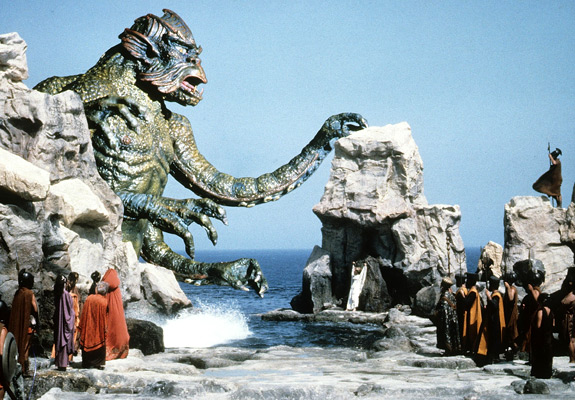Hello folks, and welcome back to Wrong Every Time. Today I am eager to finish this dang article and get the heck outside, as we’re apparently experiencing some sort of late-October summer reprise, with temperatures in the 70s even as the leaves fall from the trees. You gotta take what victories you can during our ongoing environmental collapse, but fortunately for you all, this unexpected bounty of perfect weather has not stopped me from huddling inside and watching movies all week. This week I’ve got epic adventures, sordid slashers, and also a gorgeous anime feature by a man who is rocketing up my list of favorite directors. Let’s break ‘em all down!
First up this week was the 1981 Clash of the Titans, featuring Harry Hamlin as Perseus and Lawrence Olivier as Zeus. The film goes through a loose interpretation of Perseus’ various legends, setting him against gorgons and krakens and whatnot, and offering him a nemesis in the form of Calibos, the son of the sea goddess Thetis. There’s plentiful swordplay, a not-terribly-convincing romance, and lots of great stop-motion highlights courtesy of the inimitable Ray Harryhausen.
Harryhausen is truly the star of this feature, with his creations offering more charismatic performances than anyone outside of Olivier. While the actual plot of Clash of the Titans is a bit lacking in focus and momentum, you can always be certain that a marvelous new creature is on the horizon, ready to raise its bulky bones and smash down on Perseus in charmingly low-frame-rate style. Among these, the highlight is easily the battle with Medusa; the gorgon herself is one of Harryhausen’s most detailed and threatening beasts, and the direction of her battle with Perseus is the film at its most thoughtful and entrancing, the camera skillfully emphasizing the lighting, sight lines, and general terror of facing a threat you cannot look upon.
That highlight aside, the film’s pleasures are scattered ones, and its embellishments clearly of its era. There are lots of flying sequences much in the style of the original Superman released three years earlier, and they hold up here just as poorly as they do in that film. There’s a mechanical owl who speaks in R2D2 noises, who I ended up far more endeared towards than I expected. And then there’s Lawrence Olivier, hamming it the hell up as Zeus and generally embodying the well-documented vanity of the Greek gods. The film’s clashes are perhaps a touch less titanic than advertised, and you could probably shave twenty minutes off its running time with little consequence, but as far as sword and sandal fare goes, it’s a generous experience.
We then continued our journey through the direct-to-video nasties franchise that is Wrong Turn, screening Wrong Turn 2: Dead End. Apparently determined to offer more of a story than “two cars crash in the woods and everyone dies,” this one introduces a survival reality show conceit, with a bunch of young would-be stars tramping around in the woods while Henry Rollins yells at them about Fear and Survival and stuff. Then more mutant hillbillies show up, and we swiftly transition back towards the steady bloodletting of the franchise’s origins.
Honestly, if not for Rollins, I’d say the reality show bits here would be a total waste of time. The film does nothing with the format, mostly just using it as an excuse for lots of erratic, poorly composed camerawork, and largely abandoning it once the killing begins. Fortunately, Wrong Turn 2 improves on its predecessor in one crucial way, which is really the only metric that matters for this sort of exploitation fare: its grimy, gross-out kills, which immediately secure a place among the most graphically inventive in the genre.
The film declares its intent in this regard right from the start, opening with a character being split in half the long way, and rarely deviating from that level of audacity moving forward. The film’s second half is thus a split between exceedingly messy kills and scenes of Henry Rollins doing his own personal Rambo impression, culminating in a confrontation beside a preposterously oversized meat grinder. Tasteless and grotesque yet never uncomfortably cruel, Wrong Turn 2 embraces its ambitions with aplomb, serving up a generously stacked plate of drive-in movie gristle.
We then checked out Lost Bullet, a recent French action film starring Alban Lenoir as Lino, a thief who is arrested after driving a reinforced, nitro-injected car straight through a jewelry store. Lino is swiftly recruited from prison by Charas (Ramzy Bedia), a detective who tasks him with souping up police cars to contend with high-speed drug runners. However, when Charas is murdered by a fellow police officer, Lino is forced to go on the run in order to avenge his partner and clear his name.
Lost Bullet is a clean, efficient action-thriller, an offshoot of the Fast & Furious formula that understands its influences and executes on them with precision. Both the fights and chase scenes are smartly conceived and skillfully executed; there is a scrappy brutality to the film’s action choreography that ensures each blow lands with impact, as Lenoir twists and grapples and uses whatever tool presents itself to fight for his freedom. And the car chases fully respect the Fast & Furious principle of “introduce at least one preposterous car-fight innovation per film,” culminating in a highway confrontation that I frankly respect too much to spoil outright. A fine, gritty little feature.
I then watched Mai Mai Miracle, an anime film directed by Sunao Katabuchi, the immensely talented director of both Princess Arete and In This Corner of the World. Katabuchi produces films of intense beauty and profound psychological complexity, exploring the lives of humans as they truly are with more acuity and world-weary empathy than basically anyone in the business. In This Corner of the World might well be my favorite animated film, and Princess Arete is not far behind it; now, I can happily add Mai Mai Miracle to his list of devastating, unimpeachable classics.
The film starts in the spring of 1955, introducing us to the energetic Shinka Aoki, a young girl who loves her rural town, and who can vividly imagine it as it was a thousand years in the past, a power she attributes to her “mai mai” tuft of unruly hair. She shares these visions with Kiiko Shumazu, a girl who’s just arrived from the big city, reeling from the death of a mother she’s already beginning to forget. Together, the two go on adventures and make new friends, sketching out the life of a princess a thousand years removed as the harsh realities of aging begin to encroach on their daydreams.
Like all of Katabuchi’s films, Mai Mai Miracle is not content with offering an obvious narrative path and a clear moral solution. Life is complicated, our path forward is often uncertain, and both joy and tragedy can strike without warning, with moments that feel like they’ll last forever disappearing in the blink of an eye. Katabuchi here articulates that truth through Mai Mai Miracle’s restless, uneven pacing; Shinka’s first walk to Kiiko’s house stretches across luxurious minutes of screentime, while their ultimate turns in fortune come swiftly, tragedies landing even before the cast understands what is happening.
Humble personal ambitions, unhappy home lives, the things we share and the things we keep – Mai Mai Miracle offers a tableau of childhood in all its splendor and terror, letting warm summer days linger in the mind, yet tempering them with the truths our smiling faces often elide. Not content with mere nostalgia, Mai Mai Miracle compliments its Totoro-esque daydreams with the wisdom of Only Yesterday and Rainbow Fireflies, while understanding that such perspective often arrives too late for children to heed its call. Bright shining fragments of joy sit roughly alongside sharp obsidian disappointments, challenging our expectation of narrative solidity with the bracing, distance-erasing contradictions of lived experience. Structurally, it calls to mind both Takahata’s features and the vignette-driven languor of Miss Hokusai, yet its final beats offer such a retroactively unifying bow that it seems almost designed to reward repeat viewings. I eagerly look forward to my next visit.




